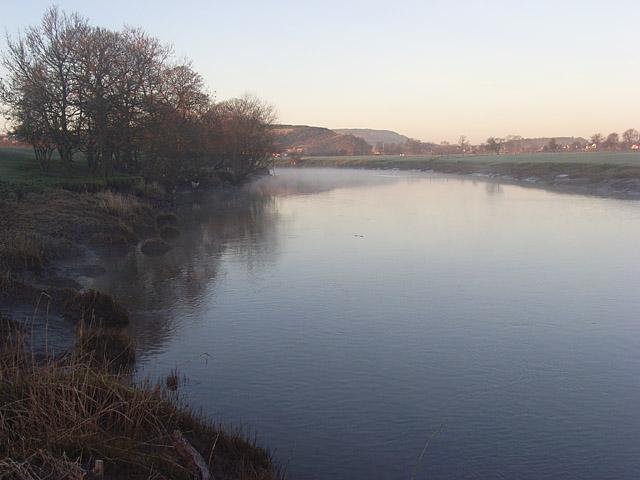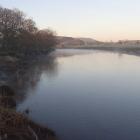In summer 1365 armed inhabitants of the royal Scottish burgh of Stirling “violently and unjustly attacked and demolished the weirs and fisheries” belonging to Cambuskenneth, a convent of Augustinian canons located across the River Forth from the town. The abbey’s founder, King David I, had in 1147 given it extensive fishing rights, which later kings and popes had augmented and confirmed. Following the attack, the abbot charged thirty-one men, led by Hugh Urry and including artisans, retailers, and eight “fishers” (piscatores), with smashing the abbey’s fisheries. King David II ordered the sheriff of Stirling to make the perpetrators reconstruct the abbey’s infrastructure within forty days and reimburse its losses.

The River Forth near Cambuskenneth, Scotland
The River Forth near Cambuskenneth, Scotland
2007 Andrew Smith
Click here to view Geograph source.
 This work is licensed under a Creative Commons Attribution-NonCommercial-ShareAlike 2.0 Generic License.
This work is licensed under a Creative Commons Attribution-NonCommercial-ShareAlike 2.0 Generic License.
Yet seen in an historical context, this seemingly simple restoration of public order reveals little-known natural wealth and resource conflict that would echo for centuries and, with analogs elsewhere, hold implications far beyond Scotland. Such disputes among landholders and fishers established the large scale of late medieval salmon runs and their value for domestic consumption and export. As mill dams blocked the migrants and agricultural clearances altered habitats, stocks reproducing in rivers of southern England and northern France dwindled, and fishmongers and consumers turned to still more productive Scottish waters. Even Scotland’s sadly exiguous sources show some churches receiving hundreds of big fishes as annual rent or tithe and shipments to Flanders, London, or Norman ports. Quantities taken on lay lordships and/or consumed at home can only be guessed from the disputes themselves.
From the 1490s to 1530s Cambuskenneth and Stirling—which itself had claimed fisheries above the abbey—again exchanged charges of illegal fishing and destruction of boats and nets. Both accepted arbitration in 1501, but the abbey rejected the decision of the royal designate, the bishop of Aberdeen. Not long thereafter, Scotland’s Reformation turned Cambuskenneth over to a lay commendatory abbot, Adam Erskine, but the struggle over salmon never ceased. Records from Erskine estates reveal continual frictions.
Like other fortuitously detailed records of historic local fisheries, documents from the disputed River Forth at Stirling reveal aspects of capture techniques and traditional ecological knowledge seldom written down in the Middle Ages. The evident shift from a fixed weir fishery of the mid-fourteenth century to the boat seines employed from the fifteenth may have been driven by the growing use of the Forth as a shipping channel to Stirling. Fixed fisheries installations elsewhere were reviled and often banned as shipping hazards. The transition from concentrating migratory salmon by an artificial barrier to encircling them with a long seine net called for working fishers to rethink their understanding of local river habitats and fish behavior. Rarely can historians so acutely see actual past individuals working in and managing their local aquatic environment.
How to cite
Hoffmann, Richard. “Rioting Townsmen Destroy Abbey’s Salmon Weir in Medieval Scotland.” Environment & Society Portal, Arcadia (2012), no. 5. Rachel Carson Center for Environment and Society. https://doi.org/10.5282/rcc/3729.
ISSN 2199-3408
Environment & Society Portal, Arcadia
 This work is licensed under a Creative Commons Attribution-NonCommercial-ShareAlike 3.0 Unported License.
This work is licensed under a Creative Commons Attribution-NonCommercial-ShareAlike 3.0 Unported License.
2012 Richard Hoffmann
This refers only to the text and does not include any image rights.
Please click on the images to view their individual rights status.
- Coates, Peter. Salmon. London: Reaktion, 2006.
- Fraser, William, ed. Registrum monasterii s. Marie de Cambuskenneth A.D. 1147–1535. Edinburgh: Grampian Club, 1872.
- Gemmill, Elizabeth, and Nicholas Mayhew. Changing Values in Medieval Scotland: A Study of Prices, Money, and Weights and Measures. Cambridge: Cambridge University Press, 1995.
- Halard, Xavier. “La pêche du saumon en Normandie du XIe au XVe siècle.” Journal of Medieval History 9 (1983): 173–178.
- Hoffmann, Richard C. “Medieval Europeans and their Aquatic Ecosystems.” In Beiträge zum Göttinger Umwelthistorischen Kolloquium 2007–2008, edited by Bernd Herrmann, 45–64. Graduiertenkolleg Interdisziplinäre Umweltgeschichte. Göttingen: Universitätsverlag, 2008. Online access.
- Summers, David W. “Scottish Salmon: The Relevance of Studies of Historical Catch Data.” In Scotland since Prehistory: Natural Change and Human Impact, edited by T. C. Smout, 98–112. Aberdeen: Scottish Cultural Press, 1993.








